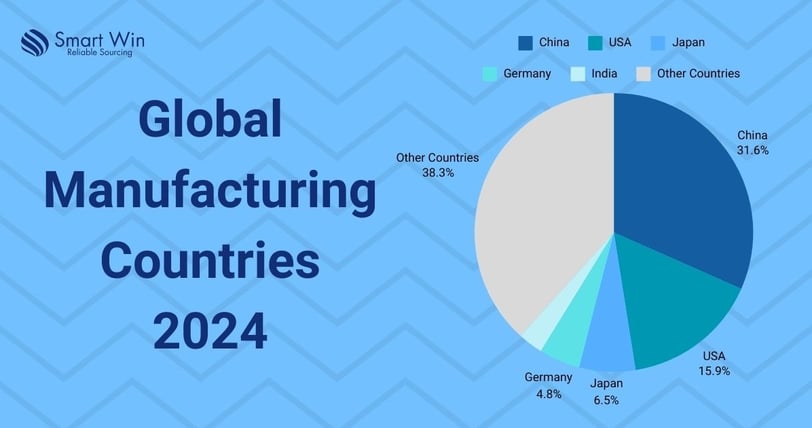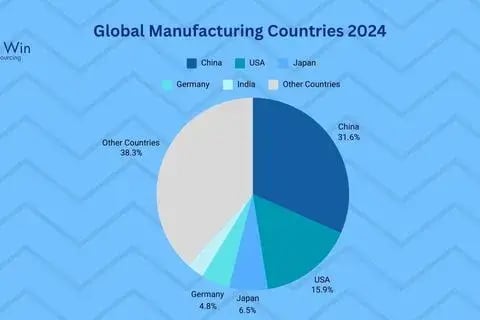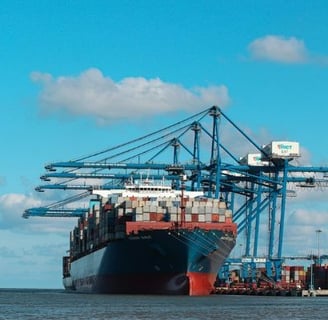[Top Tools & Tips] How to Find Reliable Suppliers in China
Find suppliers in China with these top tools & tips! Learn sourcing strategies, supplier verification, trade show hacks, and more.
12/1/20247 min read
![[Top Tools & Tips] How to Find Reliable Suppliers in China](https://assets.zyrosite.com/cdn-cgi/image/format=auto,w=812,h=344,fit=crop/YNqro9jB1VIg6bzd/722-AMqbkBO7bai5eXb5.webp)
![[Top Tools & Tips] How to Find Reliable Suppliers in China](https://assets.zyrosite.com/cdn-cgi/image/format=auto,w=328,h=320,fit=crop/YNqro9jB1VIg6bzd/722-AMqbkBO7bai5eXb5.webp)
In today’s globalized world, sourcing products from China has become a strategic move for businesses of all sizes. With over 31.63% of global manufacturing originating from China, the country offers an unparalleled supply chain network, competitive pricing, and a wide variety of products. But how do you ensure you're working with reliable suppliers who deliver on their promises? In this comprehensive guide, we’ll share practical tools and tips to help you find trustworthy suppliers in China and set your business up for success.


Table of Contents
Introduction
Why Finding Reliable Suppliers in China is Crucial
Best Platforms to Source Suppliers
How to Verify Supplier Legitimacy
Understanding Supplier Credentials
Importance of Product Quality Assessment
Role of Trade Shows in Supplier Sourcing
Effective Communication with Suppliers
Smart Negotiation Strategies
Secure Payment Methods
Avoiding Common Pitfalls
Building Long-Term Supplier Relationships
Why Finding Reliable Suppliers in China is Crucial
In the world of global trade, having a trustworthy supplier isn’t just an advantage—it’s a necessity. Unreliable suppliers can lead to delayed shipments, poor-quality products, and even financial losses. By focusing on supplier verification and employing due diligence, you can mitigate risks and create a streamlined sourcing process.
Best Platforms to Source Suppliers
When it comes to finding suppliers, the internet has made it easier than ever to connect with manufacturers in China. Here are the top platforms to kickstart your search:
1. Alibaba
Alibaba is a global leader in online marketplaces, offering access to thousands of suppliers across various industries. It’s user-friendly and provides valuable tools like supplier ratings and transaction histories to aid in your decision-making.
2. Global Sources
Known for its focus on verified suppliers, Global Sources is an excellent platform for finding manufacturers, particularly for electronics and consumer goods. The platform also offers trade show connections for face-to-face interactions.
3. Made-in-China
Made-in-China emphasizes supplier verification and detailed company profiles. It’s ideal for businesses looking for high-quality products and manufacturers with a proven track record.
4. Social Media Networks
Platforms like LinkedIn can also be invaluable. Many manufacturers actively showcase their capabilities and interact with potential clients, making it easier to gauge their expertise and professionalism.
How to Verify Supplier Legitimacy
Finding a supplier is one thing; ensuring they’re legitimate is another. Supplier verification is a critical step in safeguarding your business interests.
1. Look for Key Indicators of Reliability
Website and Online Presence: A professional website with detailed product information and certifications is often a good sign.
Supplier Ratings: Check reviews and ratings on platforms like Alibaba to see how other buyers rate their performance.
2. Conduct Background Checks
Request copies of the supplier’s business license and registration documents. Cross-check these with official Chinese government records.
3. Use Third-Party Verification Services
Engage with third-party verification services to authenticate the legitimacy of the supplier before proceeding.
Understanding Supplier Credentials
When sourcing from China, supplier credentials are a critical aspect of your due diligence process. Ensuring that a supplier meets industry standards and has the necessary certifications can save you from potential setbacks.
1. Certifications to Look For
ISO Certification: Guarantees that the supplier adheres to international quality management standards.
CE Marking: Indicates compliance with European safety, health, and environmental protection requirements, essential for products entering the EU market.
RoHS Compliance: Ensures the restriction of hazardous substances, particularly for electronics.
2. Importance of Business Licenses
Request the supplier’s business license to confirm their legal operation in China. A valid business license provides transparency and helps you avoid dealing with fraudulent entities.
3. Evaluating Supplier Experience and Reputation
Suppliers with years of experience and a strong reputation in their niche are often more reliable. Look for testimonials, reviews, or case studies that highlight their successful partnerships.
Importance of Product Quality Assessment
Ensuring product quality is one of the most critical steps when sourcing from China. Missteps here can result in customer dissatisfaction and financial losses.
1. Request Product Samples
Never skip the step of ordering samples. Samples allow you to evaluate the product’s build, functionality, and overall quality firsthand. They also serve as a benchmark for future orders.
2. Conduct Factory Audits
A factory audit involves visiting the manufacturer’s facility to assess their production processes, capabilities, and quality control measures. If you can’t visit in person, consider using third-party inspection services.
3. Understand Quality Control Standards
Familiarize yourself with industry-specific quality control standards and communicate these expectations clearly to your supplier. Regular quality checks during production ensure consistency and help catch issues early.
Role of Trade Shows in Supplier Sourcing
Trade shows are a goldmine for discovering reliable suppliers and forging valuable connections.
1. Benefits of Attending Trade Shows
Firsthand Product Evaluation: Examine products up close to assess quality and innovation.
Direct Communication: Discuss your needs with suppliers face-to-face, fostering trust and clarity.
Competitive Comparison: Compare multiple suppliers within the same industry under one roof.
2. Preparing for Trade Shows
Before attending, create a list of potential suppliers, products of interest, and questions to ask. Carry enough business cards and marketing material to facilitate introductions.
3. Notable Trade Shows to Consider
Canton Fair: China’s largest trade fair, covering a vast range of industries.
East China Fair: A prominent platform for textiles and consumer goods.
Global Sources Exhibitions: Focused on electronics and fashion, offering opportunities for detailed supplier interactions.
Effective Communication with Suppliers
Clear communication lays the foundation for a successful supplier relationship. Misunderstandings can lead to delays, quality issues, and strained partnerships.
1. Best Practices for Clear Communication
Use precise language and avoid industry jargon that may not translate well.
Provide detailed specifications, including materials, dimensions, and packaging requirements.
Confirm understanding at every stage by requesting feedback or summaries of your discussions.
2. Cultural Considerations in Communication
Chinese business culture places a high value on politeness and mutual respect. Understanding these nuances, such as addressing senior representatives formally and avoiding aggressive tones, can foster goodwill.
3. Tools for Effective Collaboration
Leverage technology for seamless communication. Platforms like WeChat and email remain popular for supplier interactions, while video conferencing tools like Zoom enable face-to-face meetings when in-person visits aren’t possible.
Smart Negotiation Strategies
Negotiating with suppliers requires a fine balance between assertiveness and collaboration. The goal is to establish a mutually beneficial partnership without compromising on quality or delivery timelines.
1. Understanding Pricing Structures
Before entering negotiations, research market rates for your desired products. Understanding typical pricing structures ensures you recognize whether a quote is fair, overpriced, or suspiciously low.
2. Building Win-Win Relationships
Focus on creating partnerships rather than short-term transactions. Emphasize the potential for long-term collaboration, which can encourage suppliers to offer better terms, discounts, or priority treatment.
3. Tips for Successful Negotiations
Be clear about your budget and expectations upfront.
Use leverage, such as large orders or referrals, to negotiate better terms.
Avoid rushing; patience is key to securing the best deal.
By relying on experienced sourcing agents like Smart Win, you can gain access to suppliers with pre-negotiated pricing, saving time and ensuring favorable agreements.
Secure Payment Methods
Payment safety is a crucial consideration when dealing with international suppliers. Fraudulent transactions or mismanaged funds can result in significant losses.
1. Common Payment Methods
PayPal: Offers buyer protection and is a popular choice for smaller transactions.
Letter of Credit (LC): Ensures payment is only made once the supplier meets predefined conditions, ideal for large orders.
Telegraphic Transfer (TT): A secure but less flexible option that requires careful due diligence.
2. Protecting Against Fraudulent Transactions
Use escrow services to ensure funds are only released upon satisfactory delivery.
3. Setting Up Secure Payment Terms
Negotiate payment milestones, such as 30% upfront and 70% upon product inspection or shipment. This approach protects both parties and builds trust over time.
Avoiding Common Pitfalls
Even seasoned importers can make mistakes when sourcing from China. Here are some common pitfalls and how to avoid them:
1. Misunderstanding Supplier Capabilities
Not all suppliers can meet large order quantities or strict quality standards. Conduct factory audits or work with a sourcing agent to confirm capabilities.
2. Ignoring Quality Assurance Measures
Overlooking regular inspections can lead to subpar products. Implement thorough quality control checks during and after production.
3. Underestimating Shipping Times and Costs
International shipping involves unpredictable delays and fluctuating costs. Partner with a logistics expert to streamline shipping and manage unforeseen issues effectively.
Building Long-Term Supplier Relationships
Strong supplier relationships are the cornerstone of a sustainable sourcing strategy.
1. Importance of Communication and Feedback
Regular communication and constructive feedback strengthen trust and ensure continuous improvement in product quality and delivery.
2. Strategies for Building Trust
Be transparent about your expectations and share future plans.
Honor payment agreements promptly to demonstrate reliability.
Visit suppliers periodically to build rapport and assess progress.
3. Benefits of Long-Term Partnerships
A reliable supplier relationship can result in:
Preferential pricing and priority access to new products.
Enhanced flexibility during urgent or custom orders.
Reduced risks through established mutual trust.
Conclusion
Finding reliable suppliers in China is an essential step toward a successful global sourcing strategy. By utilizing the right tools, conducting thorough due diligence, and fostering strong relationships, you can minimize risks and maximize opportunities.
Working with an experienced sourcing partner like Smart Win streamlines the process, offering expertise in supplier sourcing, quality assurance, and logistics management. With these top tips and tools at your disposal, your business is well-positioned to thrive in the competitive global market.
Ready to elevate your sourcing game? Reach out to Smart Win today and start your journey toward seamless product sourcing!
FAQs:
How do I handle language barriers when dealing with Chinese suppliers?
Language barriers can be challenging, but tools like translation apps, hiring bilingual staff, or working with a sourcing agent can bridge the gap. Clear, concise communication and using visuals like product diagrams can also help.Can I negotiate minimum order quantities (MOQs) with suppliers?
Yes, MOQs are often negotiable, especially for long-term clients or during economic downturns. Communicate your constraints and explore alternatives like paying a higher unit price for smaller orders.What should I do if my supplier delays shipment?
If delays occur, first communicate to understand the reason. Keep records of agreements and timelines. Mitigate future risks by adding penalties for delays in contracts or maintaining a backup supplier.How can I protect my product design from being copied?
Use non-disclosure agreements (NDAs), patent your design in China, and work with trustworthy suppliers.


Get in touch
Our Address
No.202 Huanshi West Rd, Yuexiu District Guangzhou, China
Contact Us
Working hours
Monday - Saturday
9:00 - 18:00
( Beijing Standard Time )
Smart Win Services


Company




